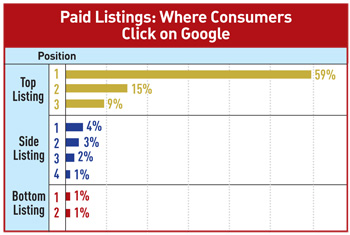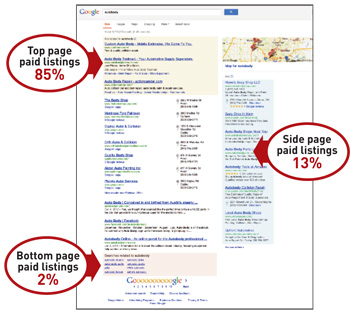 As has been revealed in my previous columns, having your website show up on page one of an Internet search is crucial. Being in position No. 1, organically, is coveted. By “organically,” we mean the actual ranking the site earns when a person searches using certain words (known as the “search query”). According to new research from Compete.com, the top five organic search results get the following percentages of clicks:
As has been revealed in my previous columns, having your website show up on page one of an Internet search is crucial. Being in position No. 1, organically, is coveted. By “organically,” we mean the actual ranking the site earns when a person searches using certain words (known as the “search query”). According to new research from Compete.com, the top five organic search results get the following percentages of clicks:
Position #1: 53%
Position #2: 15%
Position #3: 9%
Position #4: 6%
Position #5: 4%
Very few people venture much beyond the first page of a search, which is usually the top ten positions. Do you? Only 0.7 percent of people click on position No. 11 in a search; that’s the top of page two. Only 0.3 percent of people click on position No. 21 (top of page three), 0.1 percent click on position 31 (top of page four) and 0.05 percent click on position 41 (top of page five). Yikes!
This says that page one positioning in a search is crucial to your website’s visibility under the search terms people use to find the services you provide. That’s what search engine optimization (SEO) is all about. Ranking on page one may be easy in a small town, but it can be extremely difficult in major markets.
Promises, Promises
No developer can ethically promise you page one positioning or position one, but many do. That’s beyond anyone’s control. If someone tells you that, show them the door or hang up on them. SEO specialists such as Optima Automotive have a track record of achieving much improved rankings, and many page one or even position one rankings, but you’ll never hear them make promises like that. So what can you do about this?
There is one way that you can be assured of being on page one: “pay-per-click” advertising, or “search engine marketing.” Google (67 percent of search engine market share), Bing and Yahoo (28.5 percent of market share collectively, since Microsoft controls both) each can offer you the opportunity to spend money to buy a position on page one. Your listing, with your shop name, Web address and ad copy, will show up either on the top, on the side or at the bottom of page one, depending on how much you wish to spend.
The costs vary greatly based on the size and competitiveness of your market, so I won’t quote any prices here. To find out, go to the following links, purchase keywords and phrases, and test them out:
Google: http://www.google.com/ads/adwords
Yahoo: http://advertising.yahoo.com/
Bing: http://advertise.bingads.microsoft.com/en-us/reachyournextcustomer
Here are the keywords and phrases you’re going to want to bid on for sure: “auto body”; “autobody”; “auto body shop”; “body shop”; “auto body repair”; “autobody repair”; and “collision repair.” Also, “collision repair shop” plus the following: the name of your town followed by the two-letter abbreviation for your state, no comma, and the names of each of your surrounding towns that you draw work from, followed again by the state abbreviation. You may also want to purchase those keywords and add your ZIP code.
There are many more, but this gets you off to a great start. You can set your monthly budget at whatever you want and get reports on the traffic these ads generate for you.
 Top or Bottom?
Top or Bottom?
You will also have to choose which section of page one you want your ad to appear in. The top, of course, is much more expensive. Why? Because that’s what people see first. The side ads are next best, and, as you might expect, the bottom is the least desirable and therefore least expensive. I wouldn’t bother with the bottom, but it won’t cost you much to try it.
In addition to the placement of your sponsored listing, you can pay more to be in a higher paid position. As you can see from our graph, 59 percent of consumers who pay attention to sponsored listings click on the first paid listing at the top of the page. That drops all the way down to 15 percent for the second paid listing.
Think carefully about the content you put in these ads. When writing the ad, consider that it needs to be compelling enough for someone to click on it.
Landing Page
If you choose to go down the pay-per-click path, you should have these “clicks” take the visitor to a special “landing page.” You’ve spent money to get that click, so give them something special. Something like, “Print this coupon and bring it in for a free…”, or “Mention this ad when you come in for an estimate. If we earn your business, we’ll give you a free gas card worth $XX…” Give them a reason beyond the normal to bring their car to you. Highlight your well-managed social media accounts, too, and give them the opportunity to “Like,” “Follow” or “+1” you.
BSB Contributing Editor Mark Claypool has more than 30 years of experience in the fields of workforce development, business/education partnerships, apprenticeships and Web presence management. He is the CEO of Optima Automotive (www.optimaautomotive.com), which provides website design, development, SEO services and social media management services. Claypool’s work history includes stints at Metro Paint Supplies, VeriFacts Automotive, the National Auto Body Council (NABC), the I-CAR Education Foundation and SkillsUSA. He is the founder of Mentors At Work and co-founder of the Collision Industry Foundation. He served, on a volunteer basis, as the SkillsUSA World Team Leader for the WorldSkills Championships from 2003 to 2011.













